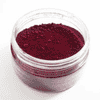
Amaranth
Hazardous
Alternate Names:
- Naphtol Rot S
- ci 16185
- ci food red 9
- fd&c red 2
- order 2
Info from food-info.net:
- Description:
- Function:
- Red food colour. Very soluble in water.
- Origin:
- Synthetic azo dye. See here for a background on azo dyes.
- Side effects:
- Since it is an azo dye, it may elicit intolerance in people intolerant to salicylates. Additionally, it is a histamine liberator, and may intensify symptoms of asthma. In combination with benzoates, it is also implicated in hyperactivity in children. A connection between tumours and amaranth has been established in rats, but not (un)proven in humans. Nevertheless, many countries have restricted the use pending further tests, and the ADI has been reduced to 0.5 mg/kg.
Dietary restrictions:- None; E123 can be consumed by all religious groups, vegans and vegetarians.
Acceptable daily intake:- Up to 0.5 mg/kg body weight.
Status:- Unknown
Info from proe.info:
- Description:
- Benefits:
- Unknown
- General:
- Unknown
- Harm:
- Unknown
- Legal:
- Unknown
- Use:
- Unknown
- Links:
- Unknown
Dietary restrictions:- Unknown
Acceptable daily intake:- Unknown
Status:- Unknown
ninamvseeno.org -- site no longer live
- Description:
- Banned in the US in 1976, banned in Russia, Austria, Norway and other countries. It can provoke an asthmatic attack, eczema and hyperactivity; caused fetal death and defects in newborn pups in animal experiments.
Dietary restrictions:- Unknown
Acceptable daily intake:- 0.150 mg/kg body weight/day (EFSA, 2010)
Status:- Approved in the EU. Banned in the United States.
References: